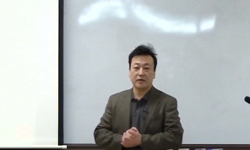산업혁명 이후 기술의 급속한 발달과 인프라스트럭처의 개발은 도시를 확장하고 발전시켰다. 하지만, 현재 도시에는 인프라스트럭처로 인한 도시공간의 분리와 단절, 공간의 비효율적 활용...
http://chineseinput.net/에서 pinyin(병음)방식으로 중국어를 변환할 수 있습니다.
변환된 중국어를 복사하여 사용하시면 됩니다.
- 中文 을 입력하시려면 zhongwen을 입력하시고 space를누르시면됩니다.
- 北京 을 입력하시려면 beijing을 입력하시고 space를 누르시면 됩니다.
https://www.riss.kr/link?id=T15782429
- 저자
-
발행사항
서울 : 중앙대학교 대학원, 2021
-
학위논문사항
학위논문(석사) -- 중앙대학교 대학원 , 건축학과 건축이론 및 설계 전공 , 2021. 2
-
발행연도
2021
-
작성언어
한국어
-
주제어
인프라텍쳐 ; 도시 ; 인프라스트럭처 ; 도시 조직 ; 도시 공간 ; 네트워크 ; Infrastructure ; Urban Tissue ; Urban Space ; Infratecture ; Mutual Causation ; Space Reconstruction ; Behavior ; Space Network ; Urban Vitalization
-
발행국(도시)
서울
-
기타서명
(A) study on the relationship between infratecture and city
-
형태사항
iv, 104 p. : 삽화, 도표 ; 26 cm
-
일반주기명
중앙대학교 논문은 저작권에 의해 보호받습니다
지도교수: 송하엽
참고문헌수록 -
UCI식별코드
I804:11052-000000234428
- DOI식별코드
- 소장기관
-
0
상세조회 -
0
다운로드
부가정보
국문 초록 (Abstract)
도시가 고도화되면서 새로이 등장한 사회적 인프라 등을 제외하고, 경제 및 생산 활동의 기반을 형성하는 인프라스트럭처와 도시의 변화는 보편사를 기준으로, 시대별로 모두 상호인과적이었다. 기술의 발달과 문화의 발달로 인한 사회적 변화가 도시의 필요에 변화를 주면, 이를 위한 인프라스트럭처는 기능적, 위상적, 관계적으로 변화하고, 도시의 공간 및 조직은 그 영향으로 변화하고 발전하였다.
현재 도시에서 이루어지고 있는 인프라스트럭처의 건축화 및 인프라텍쳐의 도시와의 관계 특성과 그로 인한 영향을 파악하기 위하여 인프라스트럭처가 인프라텍쳐로 변화하는 배경, 과정과 방법을 알아보았다. 이를 토대로 인프라텍쳐가 도시와 상호작용하는 방법을 파악하여 기반분리형, 입체복합형, 중심연결형, 지역연결형으로 유형을 분류하였으며, 각각은 특징과 도시에 주는 의미가 있다.
위 분류를 바탕으로 인프라텍쳐가 도시와 밀접한 관계를 나타내고 있는 사례를 분석함으로 인프라텍쳐가 도시에 줄 수 있는 영향을 파악하였다. 인프라텍쳐는 현대 도시에서 새로운 공공 공간 창조하면서 도시공간을 재구조화하고, 재원과 사람의 이동 흐름이 아닌 사람의 행위가 주체가 되는 흐름을 형성하며, 도시 내 지역들 간의 공간적 네트워크를 구축한다.
인프라텍쳐는 도시에 새로운 장소와 공간 네트워크를 구축함으로 현대 도시의 변화 양상에 부합하여 도시를 활성화시키는 인프라스트럭처의 변화임을 볼 수 있다. 앞으로의 도시의 변화에 대해서도 인프라텍쳐의 도시와의 관계를 중점으로 고려하여 도시를 더욱 살만한 곳으로 발달시킬 수 있는 변화가 있기를 기대한다.
산업혁명 이후 기술의 급속한 발달과 인프라스트럭처의 개발은 도시를 확장하고 발전시켰다. 하지만, 현재 도시에는 인프라스트럭처로 인한 도시공간의 분리와 단절, 공간의 비효율적 활용 등의 문제가 있다. 건축에서도 이에 대응하기 위해 ‘인프라스트럭처를 건축화‘하는 ’인프라텍쳐‘와 관련한 연구가 진행되고 있다. 본 연구는 건축적인 공간을 형성하는 것에 주목하였던 기존의 인프라텍쳐 연구를 인프라스트럭처와 도시, 그리고 그 관계까지 확장하고자 하였다.
도시가 고도화되면서 새로이 등장한 사회적 인프라 등을 제외하고, 경제 및 생산 활동의 기반을 형성하는 인프라스트럭처와 도시의 변화는 보편사를 기준으로, 시대별로 모두 상호인과적이었다. 기술의 발달과 문화의 발달로 인한 사회적 변화가 도시의 필요에 변화를 주면, 이를 위한 인프라스트럭처는 기능적, 위상적, 관계적으로 변화하고, 도시의 공간 및 조직은 그 영향으로 변화하고 발전하였다.
현재 도시에서 이루어지고 있는 인프라스트럭처의 건축화 및 인프라텍쳐의 도시와의 관계 특성과 그로 인한 영향을 파악하기 위하여 인프라스트럭처가 인프라텍쳐로 변화하는 배경, 과정과 방법을 알아보았다. 이를 토대로 인프라텍쳐가 도시와 상호작용하는 방법을 파악하여 기반분리형, 입체복합형, 중심연결형, 지역연결형으로 유형을 분류하였으며, 각각은 특징과 도시에 주는 의미가 있다.
위 분류를 바탕으로 인프라텍쳐가 도시와 밀접한 관계를 나타내고 있는 사례를 분석함으로 인프라텍쳐가 도시에 줄 수 있는 영향을 파악하였다. 인프라텍쳐는 현대 도시에서 새로운 공공 공간 창조하면서 도시공간을 재구조화하고, 재원과 사람의 이동 흐름이 아닌 사람의 행위가 주체가 되는 흐름을 형성하며, 도시 내 지역들 간의 공간적 네트워크를 구축한다.
인프라텍쳐는 도시에 새로운 장소와 공간 네트워크를 구축함으로 현대 도시의 변화 양상에 부합하여 도시를 활성화시키는 인프라스트럭처의 변화임을 볼 수 있다. 앞으로의 도시의 변화에 대해서도 인프라텍쳐의 도시와의 관계를 중점으로 고려하여 도시를 더욱 살만한 곳으로 발달시킬 수 있는 변화가 있기를 기대한다.
다국어 초록 (Multilingual Abstract)
Except for the social infrastructure which emerged as the city has advanced, changes in infrastructure that form the foundation of economic and production activities and city were mutually causal throughout universal history. When social changes caused by the development of technology and culture change the needs of cities, their infrastructure change functionally, topologically, and relationally, leading to alternation and development in their urban space and urban tissue.
The background, process, and method of the transition of infrastructure to infratecture were studied to find the characteristics of the relationship between the city and infratecture, as well as the architecturalization of infrastructure. The typology of interaction method between infratecture and city are categorized as infra-separation, mixeduse-complex, central-connection, and regional-connection type, each of which has its own features and meaning to the city.
Using the typology suggested above, case studies of infratecture which shows close relationship with city were done to understand the impact that the infratecture can have on the city. Infratecture creates new public spaces and reconstructs urban spaces in present cities, forms a new flow of people's behavior, not the flow of resources or the migration of people, and finally establishes a spatial network among urban areas.
Infratecture can be seen as a transition of infrastructure that revives the city in line with the changing patterns of present cities by building new places and spatial networks in the city. With consideration on the relationship of infratecture with cities, future cities can be expected to become more livable places according to the changes hereafter.
After the Industrial Revolution, cities expanded and advanced through the rapid development of technology and infrastructure. However, contemporary cities are facing problems such as separation and disconnection of urban spaces and inefficient utiliza...
After the Industrial Revolution, cities expanded and advanced through the rapid development of technology and infrastructure. However, contemporary cities are facing problems such as separation and disconnection of urban spaces and inefficient utilization of spaces due to infrastructure, which led to ongoing researches focusing on ‘infratecture’- the architecturalization of infrastructure - in the field of architecture. The purpose of this study is to expand the existing studies on ‘infratecture’ focused only on creating architectural spaces, to infrastructure, city, and their relationship.
Except for the social infrastructure which emerged as the city has advanced, changes in infrastructure that form the foundation of economic and production activities and city were mutually causal throughout universal history. When social changes caused by the development of technology and culture change the needs of cities, their infrastructure change functionally, topologically, and relationally, leading to alternation and development in their urban space and urban tissue.
The background, process, and method of the transition of infrastructure to infratecture were studied to find the characteristics of the relationship between the city and infratecture, as well as the architecturalization of infrastructure. The typology of interaction method between infratecture and city are categorized as infra-separation, mixeduse-complex, central-connection, and regional-connection type, each of which has its own features and meaning to the city.
Using the typology suggested above, case studies of infratecture which shows close relationship with city were done to understand the impact that the infratecture can have on the city. Infratecture creates new public spaces and reconstructs urban spaces in present cities, forms a new flow of people's behavior, not the flow of resources or the migration of people, and finally establishes a spatial network among urban areas.
Infratecture can be seen as a transition of infrastructure that revives the city in line with the changing patterns of present cities by building new places and spatial networks in the city. With consideration on the relationship of infratecture with cities, future cities can be expected to become more livable places according to the changes hereafter.
목차 (Table of Contents)
- 1. 서 론 3
- 1.1 연구의 배경 및 목적 3
- 1.1.1 연구의 배경 3
- 1.1.2 연구의 목적 5
- 1.2 연구 범위 및 방법 5
- 1. 서 론 3
- 1.1 연구의 배경 및 목적 3
- 1.1.1 연구의 배경 3
- 1.1.2 연구의 목적 5
- 1.2 연구 범위 및 방법 5
- 2. 인프라스트럭처와 도시 13
- 2.1 인프라스트럭처 13
- 2.1.1 인프라스트럭처의 개념 13
- 2.1.2 인프라스트럭처의 종류 16
- 2.2 도시와 인프라스트럭처의 변화 17
- 2.2.1 시대별 도시와 인프라스트럭처의 관계 변화 17
- 2.3 소결 56
- 3. 인프라텍쳐와 도시 61
- 3.1 인프라스트럭처의 건축화와 인프라텍쳐의 이해 61
- 3.1.1 인프라스트럭처의 건축화 61
- 3.1.2 인프라텍쳐 68
- 3.2 인프라텍쳐화 70
- 3.2.1 인프라텍쳐화 사례 70
- 3.2.2 인프라텍쳐화의 특징 74
- 3.3 인프라텍쳐와 도시 관계 유형 75
- 3.3.1 기반분리형 75
- 3.3.2 입체복합형 75
- 3.3.3 중심연결형 76
- 3.3.4 지역연결형 76
- 4. 도시와 인프라텍쳐 관계 분석 및 의의 79
- 4.1 도시와 인프라텍쳐 관계 분석 79
- 4.1.1 사례선정의 기준 79
- 4.1.2 사례 분석 80
- 4.2 도시에서의 인프라텍쳐 의의 88
- 4.2.1 현재 도시에서의 의의 88
- 4.2.2 미래의 도시 변화와 방향성 90
- 5. 결 론 93
- 참고문헌 97
- 국문초록 101
- Abstract 103












